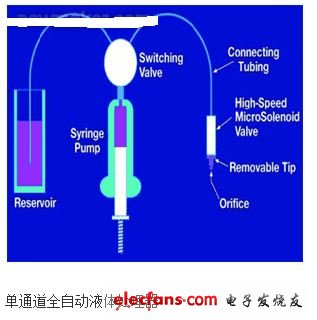Because the physical and static characteristics of different fluids are different, even if the physical dynamics of the same fluid medium under different environmental conditions are slightly different, these uncertain factors (variables) will increase the difficulty for the design engineer to implement on-demand control of the fluid. Especially in special occasions of medical diagnostic equipment and scientific analytical instruments, such as: high flow rate under low pressure conditions, requiring high precision of fluid control and meeting some professional application needs of medical instruments, system design engineers should strive to "balance" "A variety of confusing variables to achieve the development goals of system-wide performance. Based on the system ubiquity of in vitro diagnostic equipment (referred to as "diagnosis") and scientific analytical instruments (referred to as "analysis"), this paper discusses some fluid control technologies and engineering solutions.
I. Liquid handling technology and automation solutions
Liquid treatment is also called “Sampling PrepearaTIon†and “pre-analytical treatment†in diagnosis and analysis. The essence of the liquid treatment is quantitative dosing and distribution of liquids (human body fluids such as serum samples and urine). , complete the dilution or mixing action.

So far, the principles of liquid handling technology are nothing more than the following three: liquid displacement, active replacement and gas replacement. The three principles have different requirements for different applications. Among them, the latter two technologies are only used by a very small number of manufacturers in automation products due to factors related to patents, technical processes, etc., and "liquid replacement" has been widely used as the earliest liquid processing automation technology and has been used up to now.
It is well known that microsyringe pumps are a model based on the principle of liquid displacement. It consists of the following key components: a micro-injector; a shear valve and a stepper motor with integrated drive, control, and communication protocols. It can be directly applied to all diagnostic and analytical equipment that require automatic sample preparation.
Obviously, in practical applications, the above micro-syringe pump cannot completely complete the dilution and distribution of the liquid, so another key component, the aspirating sample/spike (or probe), is needed. Connect it to a function port of the shear valve on the micro syringe pump to form a “single channel fully automatic liquid processor†as shown in the figure below, supplemented by a reasonable “associated methodology protocol†software. It can create professional dilution/dispensers for analytical and diagnostic laboratories. In the fully automatic liquid handling technology, the front end needle is a key part, because the needle end of the needle must be in addition to the actual application requirements, such as the puncture function, liquid level detection function (LLD), but also consider adding The effect of sample accuracy and whether it will produce "hanging beads" and other phenomena.
However, in some high-response sensitivity diagnostic methodologies (eg chemiluminescence immunoassays with a sensitivity of 10-9 or more), although the steel needle has undergone some special treatment (eg Teflon coating), However, after repeated use for a period of time, there will still be “carrying pollutionâ€, “cross-contamination†and “dilution effectâ€, which may lead to false positives such as false positives/false negatives, and even batch tests may fail. Therefore, both the European Union IVDD 97 (In Vitro Diagnostic Equipment Directive) and the US Clinical In Vitro Diagnostic Guidelines indicate that a disposable TIp head (tip) should be used. In this way, it is necessary to improve the part directly contacting the liquid (ie, the front end steel needle), transform the front end part into a mechanical structure capable of automatically loading and unloading the disposable TIp head, and requires embedded high speed (response speed "3ms", extremely low inside A miniature electromagnetic medium isolation valve with a volumetric quantity and a "zero" dead space. With the continuous innovation of diagnostic methodology, how to increase the amount of sample loading from “micro-liter†to “nanoâ€, how to meet such high precision requirements? We can consider implementing this by embedding a microfluidic sensor on the front end structure and supplementing the peripheral closed loop control circuit.
LED Ceiling Light, LED Down Light, LED Recessed Ceiling Light
LED Ceiling Light
LED Ceiling Light, LED Down Light, LED Recessed Ceiling Light
Shenzhen Ri Yue Guang Hua Technology Co., Ltd. , https://www.ledlightinside.com